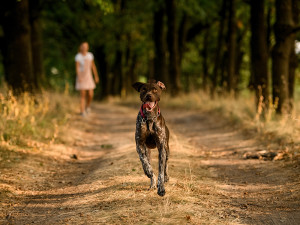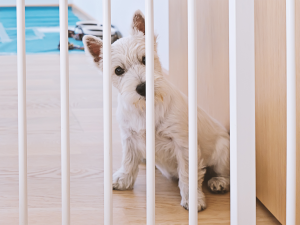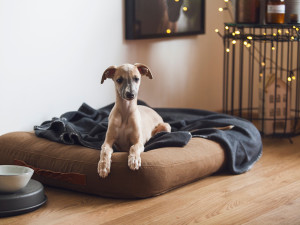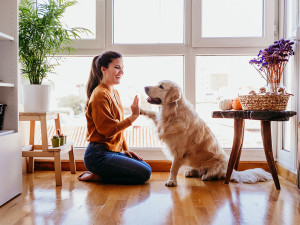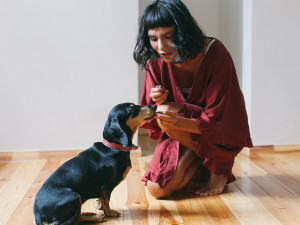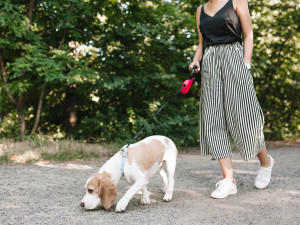How to Stop Your Escape-Artist Dog From Making a Getaway
Dog trainer Pat Miller’s pro tips for preventing your pup from darting out the door.

share article

Your pet wants you to read our newsletter. (Then give them a treat.)
Have a four-legged Houdini on your hands? It’s less cute than it sounds — and sometimes scary. A dog who slips through an open door every chance they get is frustrating for you and dangerous for them. Exploring the fenced backyard? Fine. Sprinting down the middle of a busy street? Not so much.
Why would a well-loved pet with ample food, water, toys, and human attention choose to escape? Because it’s fun! The outside world can be endlessly reinforcing for a dog. If you have a dog who sniffs and investigates everything on walks, you know that from experience. The door-darter has also learned that dashing outside is a great way to get their couch-potato human to play with them — which further encourages their dramatic escapes. Plus, if you’ve ever reprimanded your dog when you finally got your hands on them, you’ve taught them that being captured makes bad stuff happen (hello, yelling) and the good stuff go away (bye-bye, playtime).
Making good stuff go away is the definition of “negative punishment,” and making bad stuff happen is “positive punishment.” Your pup’s getting punished twice, and here’s the kicker: They won’t associate either punishment with their initial door-darting. Nope, they’ll instead connect both of those consequences with you catching them, which will make it even harder to retrieve them the next time they get loose. Here’s exactly what to do if your dog is a door-darter:
Get them back.
Anyone with a door-darter might say this is easier said than done. An accomplished door-darter is often an accomplished keep-away player as well. Don’t chase your dog; you’ll just be playing their gameopens in a new tab. Instead, try a different tack. Grab a squeaky toy, take it outside, and make it squeak. It may be counter-intuitive, but when your dog looks, run away from them, still squeaking the toy. If your dog chases you, let them grab one end of the toy. Play tug, trade the toy for a treat, then squeak and play some more. Let them follow you, playing tug, into your fenced yard, then close the gate (or into your garage or house if you don’t have a fence).
Or, if your dog loves car rides, run to your car and say, “Wanna go for a ride?” Open the door, and when they jump in, follow through on your promise and take them for a cruise. Chasing tennis balls or flying discs? Fetching sticks? Walkies? Whatever gets their tail wagging with excitement, offer it.
Once you’ve corralled your wandering pup, the part about punishment bears repeating: No matter how upset you are, don’t yell. Don’t even reprimand them calmly. And don’t take your dog back inside immediately — that’s punishment, too. Stay outside and play a while. If you punish them or march them sternly back into the house, they’ll be harder to catch the next time. Instead, happily and genuinely reinforce their responding to you with whatever they love best.
Block their escape route.
If you can’t fence in your entire yard, perhaps you can fence a small area outside the door(s) or install a barrier outside, like a small area with a self-closing gate. A physical barrier is better than a shock fence, as determined dogs will run through those as easily as through open doors.
Baby gates or exercise pens inside can block your dog’s access to escape. Insist that everyone — family and guests alike — makes sure the dog is behind the barrier before they go out the door or greet a visitor.
Put your pup through their paces.
Increasing your dog’s level of aerobic exercise is another way to reduce the darting. If you keep your pup busy and tired, they’ll be less likely to look for opportunities to make a break for it.
Train them to wait at doors.
Teach your dog to wait at doors until they’re given the release cue. With your dog sitting beside you at a door that opens outward, tell them to wait. Reach toward the doorknob. If they don’t move toward the door, click your clicker or use a verbal marker and give them a tasty treat. Repeat, moving your hand closer toward the doorknob in small increments, clicking and treating each time they remain seated.
If your dog gets up, say, “Oops!” have them sit, then try again. If they get up several times in a row, you’re asking too much of them; go back to moving your hand only a few inches toward the knob, and advance more slowly.
When they stay sitting, touch the knob. Click/treat. Jiggle the knob. Click/treat. Repeat, clicking and treating each time, then open the door a crack. If your dog doesn’t move, click and treat. If they get up, say, “Oops!” and close the door. You’re teaching them that getting up closes the door; if they want the opportunity to go out, they must wait.
Gradually open the door in one or two-inch increments. Any time they get up, say, “Oops” and start over. Do several repetitions at each step. When you can open the door all the way, take one step through, stop, turn around, and face your dog. Wait a few seconds, click, then return and treat.
When your dog is solid with you walking through the door and doesn’t run out, occasionally invite them to go out ahead of, with or after you, by using a release cue such as “free.” Other times, walk through the door and close it, leaving them inside. Once the door closes, they’re free to get up and move around. You can give your release cue through the closed door, or simply leave them to figure out it’s okay once you’re gone. They will figure it out.
Finally, teach everyone who interacts with your dog how to ask for the “Wait” at the door. The more consistent everyone is at reinforcing this command, the more reliable your dog will be at waiting — and the less likely they’ll be to run out of the house. And that’s a winning combination.
Pat Miller, CPDT-KA
Pat Miller is a certified dog behavior consultant, dog trainer, author of six books on dog training and behavior, and presents seminars worldwide.
Related articles
![A woman holding a dogs paw and smiling.]() opens in a new tab
opens in a new tabNine Useful Tricks to Teach Your Dog
Go beyond the basics.
![Dog sitting in a newly unpacked living room with moving boxes around]() opens in a new tab
opens in a new tabMaking a Move? Here’s How to Help Your Dog Adjust to Your New Digs
Your dog loathes moving, too. These tips will make it easier on everyone.
![woman gives small black dog treat for sitting]() opens in a new tab
opens in a new tabYour Dog Should Do This 30-Day Training Challenge
It’s like your 30-day yoga challenge — except with way more training treats.
![Woman in vintage striped pants walking in park while her pet is following the trail. Cute beagle dog sniffs something on the path in morning.]() opens in a new tab
opens in a new tabDoes Your Dog Have a Nose For Scent Training?
This sounds like a competition show waiting to happen.
